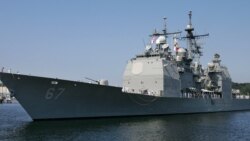The United States is committed to defending its allies and has deployed American forces in the Asia-Pacific against regional missile threats.
Clearly, the biggest ballistic missile threat in the area comes from North Korea, said U.S. Assistant Secretary of State for Arms Control, Verification and Compliance Frank Rose. As recently as April 15 and 28, North Korea carried out launches of intermediate-range ballistic missiles, which failed. On April 23, North Korea tested a submarine-launched ballistic missile, which also failed. On March 11 and 18, North Korea launched its short-and medium-range Scud and No Dong ballistic missiles.
North Korea has several hundred short- and medium-range ballistic missiles available for use against targets on the Korean Peninsula and Japan. Launches using ballistic missile technology are clear violations of multiple UN Security Council resolutions.
The U.S. has its strongest missile defense relationship in the region with Japan. The U.S. deploys Aegis Ballistic Missile Defense, or BMD, ships and Patriot batteries in Japan to support the defense of Japan and U.S. deployed forces.
Japan currently deploys four Kongo-class Aegis BMD destroyers, is upgrading two Atago-class destroyers to BMD capability, and has plans to acquire two more Atago-class BMD ships. It also deploys 24 Patriot batteries along with its own extensive early warning radar network.
The United States and Japan are working closely together to develop the SM-3 Block IIA interceptor. This development work remains on track for delivery in the 2018 timeframe.
With regard to South Korea, the U.S. currently deploys Patriots to defend American forces and South Koreans. South Korea has also been improving its own missile defense capabilities with the Korean Integrated Air and Missile Defense system.
The U.S.-South Korea Alliance "could benefit from more 'upper tier' missile defense capabilities to address the threat from North Korea’s extended range SCUDs and No Dong medium-range ballistic missiles," said Assistant Secretary Rose. That’s where the Terminal High Altitude Area Defense, or THAAD, system comes in.
The U.S. and South Korea have begun formal consultations on the potential deployment of such a system. If THAAD is deployed in the Republic of Korea, it would be focused solely on defending against North Korean ballistic missile threats.
The United States remains committed to defending its allies and forces in the face of North Korea’s UN-proscribed ballistic missile launches and nuclear tests.

















